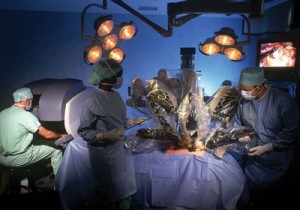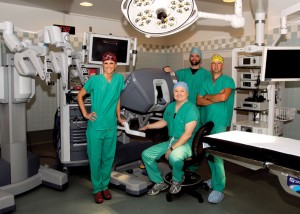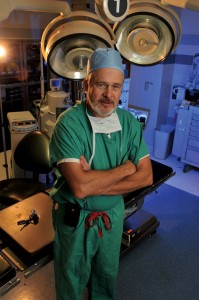 Science fiction has made the existence and progression of robotics both a powerful and somewhat frightening possibility for the future. In novels and movies, robots have been known to override computer systems to gain control of humans or extinguish the human race in its entirety in an effort to take over the world.
Science fiction has made the existence and progression of robotics both a powerful and somewhat frightening possibility for the future. In novels and movies, robots have been known to override computer systems to gain control of humans or extinguish the human race in its entirety in an effort to take over the world.
In reality, the possibilities that lie within robotics are seemingly endless, the benefits for humans even more so. Robots are built sturdy and meant to last, and they provide—especially for the medical community—hope, unlike their fictitious counterparts. With today’s technology and the continuing expansion of robotic use, doctors and surgeons around the world are providing better care, more effective treatment and greater hope to their patients.
West Virginia is no stranger to the concept of robotics combined with medicine. Because the use of robotics can take more clear images of vital organs within the body and make smaller surgical incisions that result in quicker healing and less scar tissue, our hospitals are embracing the recent and continuous developments within the medical robotics industry.
Two medical institutions in West Virginia that have embraced robotics and utilized it in the treatment of patients are Thomas Memorial Hospital in South Charleston and Cabell Huntington Hospital in Huntington. Thomas’ use of the da Vinci® Si™ Surgical System enables gynecologic surgeons in particular to more efficiently and effectively perform hysterectomies and treat other gynecologic problems in women while Cabell Huntington has used da Vinci® Surgery to perform robotic prostatectomies, a treatment for prostate cancer that has also led to the development of advanced treatment for kidney and bladder cancer.
Thomas Memorial Hospital
 One of the most important additions to health care in the Kanawha Valley in the past 12 months has been Thomas Memorial Hospital’s introduction of the da Vinci® Si™ Surgical System to the community. This technology allows for extremely accurate and minimally invasive surgical performance, resulting in less pain, smaller scars and quicker recovery for patients.
One of the most important additions to health care in the Kanawha Valley in the past 12 months has been Thomas Memorial Hospital’s introduction of the da Vinci® Si™ Surgical System to the community. This technology allows for extremely accurate and minimally invasive surgical performance, resulting in less pain, smaller scars and quicker recovery for patients.
The unique features of da Vinci® Si™ now provide clinical benefits and efficiency in the operating room, many of which translate to patient benefits. These features include an enhanced 3D, high definition vision of the operative field with up to 10x magnification; a new optional dual console that allows a second surgeon to provide assistance; superior visual clarity of tissue and anatomy; surgical dexterity and precision that is far greater than even the human hand; updated and simplified user interface to enhance operating room efficiency and the most modern ergonomic settings for greater surgeon comfort.
“This technology takes surgery beyond the limits of the human hand,” explains Steve Dexter, president and chief executive officer of Thomas Health System. “With advancements that provide surgeons with unparalleled precision, dexterity and control,” Dexter continues, “the new features of the da Vinci® Si™ System will ensure the best possible outcomes for our patients. This is yet another step in our ongoing commitment at Thomas to provide our community with access to the latest advancements in minimally invasive surgery.”
Currently, those most likely to benefit from Thomas’ da Vinci® Si™ surgery are gynecological patients requiring surgery for the treatment of fibroids, endometriosis or heavy periods. “If your doctor recommends a hysterectomy,” explains Dr. Bernard Luby, a gynecologist at Thomas Memorial Hospital, “da Vinci Hysterectomy may be one of the most effective, least-invasive treatment options for a range of uterine conditions.”
Hysterectomies performed on the da Vinci® Si™ Surgical System enable surgeons to perform with unmatched precision and control—using only a few small incisions. “The da Vinci® Si™ Surgical System is allowing Thomas to provide superior vision and dexterity in dealing with the most pathology issues,” says Luby.
Patients who would normally encounter a large incision and a long hospital recovery now can often return home in less than 24 hours with less complications and pain.
Luby notes that for most patients, da Vinci Hysterectomy can offer numerous potential benefits over traditional approaches to vaginal, laparoscopic or open abdominal hysterectomy, particularly when performing more challenging procedures like radical hysterectomy for gynecologic cancer. “The most positive patient benefits,” says Luby, “are significantly less pain, less blood loss, fewer complications, less scarring and a shorter hospital stay.” These key benefits are common when utilizing the da Vinci® Si™ Surgical System.
Cabell Huntington Hospital
 The proven track record of da Vinci® surgeons at Cabell Huntington Hospital had its starting point in 2006 when the hospital became the first in the Huntington/Tri-State region to offer patients this state-of-the-art option. Since that time, an experienced team of robotic surgeons has changed the way many patients experience surgery, but none more significantly than patients with prostate cancer.
The proven track record of da Vinci® surgeons at Cabell Huntington Hospital had its starting point in 2006 when the hospital became the first in the Huntington/Tri-State region to offer patients this state-of-the-art option. Since that time, an experienced team of robotic surgeons has changed the way many patients experience surgery, but none more significantly than patients with prostate cancer.
Men come to Dr. James Jensen, associate professor of Urological Oncology at the Marshall University Joan C. Edwards School of Medicine and director of Robotic Surgery at the Edwards Comprehensive Cancer Center at Cabell Huntington Hospital, for his experience and reputation as one of the country’s leading robotic surgeons. While performing nearly 1,000 surgeries, Jensen has drawn national and international attention from patients who are traveling to Huntington for care to treat prostate cancer.
“These patients could go anywhere in the world for their care,” Jensen says, “but what they find here at the Edwards Comprehensive Cancer Center is a team with experience, advanced techniques and careful attention to detail. Those all lead us to good patient outcomes with da Vinci® surgery.”
Jensen’s successes with da Vinci® Surgery for prostate cancer, known as a robotic prostatectomy, have led to the development of more advanced techniques for the treatment of kidney and bladder cancer and the expansion of the program to include surgery for some gynecologic procedures and abdominal cancer treatment by surgical oncologist Wade Douglas, M.D. and obstetrician-gynecologist Brenda Dawley, M.D.
Since its introduction, da Vinci® Surgery has been touted as a minimally invasive option for patients who can see a faster recovery from their procedure. Jensen has seen those results firsthand.
“I have removed the prostate from every angle and approach, and there is no better way to do a prostatectomy, as far as I am concerned,” Jensen says.
While the term robotic surgery is generally used to describe the da Vinci® technology, the system cannot operate or make decisions on its own. To perform a procedure, the surgeon uses the console’s master controls to maneuver the system’s four robotic arms, which securely hold the micro-instruments and the endoscopic camera.
Patients have traveled long distances to come to Huntington for their care, including John Edwards, a resident of Idaho Falls, ID, and Duane Wise from Anchorage, AK. Both men traveled far and bypassed many other hospitals where they could have had their cancerous prostate removed using the da Vinci® procedure.
Men who are diagnosed with prostate cancer are researching their treatment options more than ever, and many are choosing to undergo the minimally invasive da Vinci® procedure.
“It’s clear that, using this minimally invasive technique, men are seeing that removing the cancer and the prostate is the fastest and most effective treatment for prostate cancer,” says Jensen. “We continue to see great patient experiences using da Vinci® that include lower risks for erectile dysfunction and incontinence.”
Improving results is Jensen’s primary objective, and some men currently recover erectile function before their catheter is removed.
“We follow our results carefully, and recent results are better than ever in this regard,” he explains.
The robotic techniques used at Cabell Huntington Hospital have been evolving since the inception of the program, and there are two relatively new developments. In the area of benign prostatic hyperplasia, a problem afflicting millions of men in this country, Jensen has performed a procedure called Robotic Simple Prostatectomy for men with large prostates who cannot be treated by other means. Results of early experiences with this procedure are very promising and were reported last summer in the “Journal of Robotic Surgery.”
In the area of prostate cancer, Jensen has also worked to help men retain their normal quality of life following a robotic procedure. “We have been working to improve early potency for men who are sexually active before the procedure,” says Jensen.



